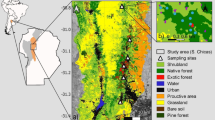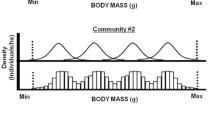Abstract
Cumulative impacts of logging and road building in a previously undisturbed tract of tropical rain forest in French Guiana were assessed by random sampling of the bird community and 1-km2 plot counts of diurnal raptors. Similar surveys were carried out during road construction and 15 years later within 5km of the road and were also compared with the undisturbed bird community of a nearby primary forest. The main disturbance was the change in forest structure brought about by logging and secondarily the road opening, the roadside second growth and the depletion of large vertebrates by hunting pressure. The responses of different bird guilds were highly divergent according to their natural habitat requirements, their diet and their vulnerability to hunting. They resulted in a moderate decrease in overall species richness and equitability. All species pooled, the abundance of 118 species was lowered, that of 45 species did not change appreciably and 89 were favored or even appeared. The guilds most affected were those with large body sizes, from terrestrial foragers to canopy frugivores, mostly by hunting, and the open understorey specialists, notably large insectivores and mixed flock members, because of changes in forest structure after logging. The guilds favored by logging and road opening were many of the hummingbirds, upper canopy frugivores and omnivores, and gap, edge or low secondary growth specialists. Recommendations to minimize the negative consequences of human exploitation in rain forests include reducing the width of deforested roadsides to no more than 10–15m on either side, implementing much more careful logging practices and strongly limiting hunting pressure in newly opened areas.
Similar content being viewed by others
References
Anon (1979) Atlas des départements français d'OutreMer. Volume IV. La Guyane. Bordeaux, France: GEGET, ORSTOM
August PV (1983) The role of habitat heterogeneity in structuring tropical mammal communities. Ecology 64:1495–1507
Baltanas A (1992) On the use of some methods for the estimation of species richness. Oikos 65: 484–492
Bennett EL and Dahaban Z (1995) Wildlife responses to disturbances in Sarawak and their implications for forest management. In: Primack RB and Lovejoy TE (eds) Ecology, Conservation and Management of Southeast Asian Rain Forests, pp 66–86. Yale University Press, New Haven
Bierregaard RO and Lovejoy TE (1989) Effects of forest fragmentation on amazonian understory bird communities. Acta Amazonica 19: 215–241
Blockhus JM, Dillenbeck M, Sayer JA and Wegge P (1992) Conserving Biological Diversity in Managed Tropical Forests. IUCN, Gland, Switzerland
Derleth EL, McAuley DG and Dwyer TJ (1989) Avian community response to small-scale habitat disturbance in Maine. Canadian Journal of Zoology 67: 385–390
Desrochers A and Hannon SY (1997) Gap crossing decisions by forest songbirds during the post-fledging period. Conservation Biology 11: 1204–1210
Fuller MR and Mosher JA (1987) Raptor survey techniques. In: Giron Pendelton BA, Millsap BA, Cline KW and Bird DM (eds) Raptor Management Techniques Manual, pp 37–66. National Wildlife Federation, Washington DC
Gates JE and Giffen NR (1991) Neotropical migrant birds and edge effects at a forest-stream ecotone. Wilson Bulletin 103: 204–217
Gaston KJ (ed) (1996) Biodiversity. A Biology of Numbers and Difference. Blackwell Science, Oxford
Germaine SS, Vessey SH and Capen DE (1997) Effects of small forest openings on the breeding bird community in a Vermont hardwood forest. Condor 99: 708–718
Glitzenstein JS, Harlombe PA and Streng DR (1986) Disturbance, succession and maintenance of species diversity in an east Texas forest. Ecological Monographs 56: 243–248
Goosem M (1997) Internal fragmentation: the effects of roads, highways and powerline clearings on movements and mortality of rain forest vertebrates. In: Laurance WF and Bierregaard RO (eds) Tropical Forest Remnants, pp 241–255. University Chicago Press, Chicago
Hockin D, Ounsted M, Gorman M, Hill D, Keller V and Barker MA (1992) Examination of the effects of disturbance on birds with reference to its importance in ecological assessment. Environmental Management 36: 253–286
Hoyo J del, Elliott TA and Sargatal J (1994) Handbook of the Birds of the World, Volume 2. Lynx Edicions, Barcelona
Johns AD (1985) Selective logging and wildlife conservation in tropical rain forest: problems and recommendations. Biological Conservation 31: 355–375
Johns AD (1986) Effects of selective logging on the ecological organization of a peninsular malaysian rain forest avifauna. Forktail 1: 65–79
Johns AD (1988) Effects of selective timber extraction on rain forest structure and composition and some consequences for frugivores and folivores. Biotropica 20: 31–36
Johns AD (1991) Responses of amazonian rain forest birds to habitat modification. Journal of Tropical Ecology 7: 417–437
Johns AD (1996) Bird population persistence in Sabahan logging concessions. Biological Conservation 75: 3–10
Johns JS, Barreto P and Uhl C (1996) Logging damage during planned and unplanned logging operations in the eastern Amazon. Forest Ecology and Management 89: 59–77
Jullien M and Thiollay JM (1996) Effects of rain forest disturbance and fragmentation: comparative changes of the raptor community along natural and human-made gradients in French Guiana. Journal of Biogeography 23: 7–25
Karr JR (1981) Surveying birds in the tropics. Studies in Avian Biology 6: 548–553. Cooper Ornithological Society
King DI, Griffin CR and de Graaf RM (1997) Effect of clearcut borders on distribution and abundance of forest birds in northern New Hampshire. Wilson Bulletin 109: 239–245
Kroodsma RL (1984) Effect of edge on breeding forest bird species. Wilson Bulletin 96: 426–436
Kroodsma RL (1987) Edge effect on breeding birds along power-line corridors in East Tennessee. American Middland Naturalist 118: 275–283
Lambert FR (1992) The consequences of selective logging for Bornean lowland forest birds. Philosophical Transactions of the Royal Society, London B 335: 443–457
Laurance WF (1991) Edge effects in tropical forest fragments: applications of a model for the design of nature reserves. Biological Conservation 57: 205–219
Lent RA and Capen DE (1995) Effects of small scale habitat disturbance on the ecology of breeding birds in a Vermont hardwood forest. Ecography 18: 97–108
Levey DJ (1988) Tropical wet forest treefall gaps and distributions of understorey birds and plants. Ecology 69: 1076–1089
Magurran AE (1988) Ecological Diversity and its Measurement. Croom Helm, London
Malcolm JR (1994) Edge effects in central amazonian forest fragments. Ecology 75: 2438–2445
Murcia C (1995) Edge effects in fragmented forests: implications for conservation. Trends of Ecology and Evolution 10: 58–62
Noss RF (1991) Effects of edge and internal patchiness on avian habitat use in an old-growth Florida hammock. Natural Areas Journal 11: 34–47
Paton PW (1994) The effect of edge on avian nest success: how strong the evidence? Conservation Biology 8: 17–26
Peres CA (1990) Effects of hunting on western amazonian primate communities. Biological Conservation 54: 47–59
Poulsen BO (1994) Movements of single birds and mixed species flocks between isolated fragments of cloud forest in Ecuador. Studies in Neotropical Fauna and Environment 29: 149–160
Raiivio S and Haila Y (1990) Bird assemblages in silvicultural habitat mosaics in Southern Finland during the breeding season. Ornis Fennica 67: 73–83
Rappole JH and Morton ES (1985) Effects of habitat alteration on a tropical avian forest community. In: Buckley PA et al. (eds) Neotropical Ornithology, pp 1015–1021. American Ornithologists' Union Monographs No. 36, Washington DC
Reed RA, Johnson-Barnard J and Barker WL (1996) Contribution of roads to forest fragmentation in the Rocky Mountains. Conservation Biology 10: 1098–1106
Reese KP and Ratti JT (1988) Edge effect: a concept under scrutinity. Trans North American Wildlife Natural Resources Conference 53: 127–136
Reijnen R and Foppen R (1994–1995) The effect of car traffic on breeding bird populations in woodland. Journal of Applied Ecology 31: 85–94 and 32: 481–491
Schemske DM and Brokaw N (1981) Treefalls and the distribution of understorey birds in a tropical forest. Ecology 62: 938–945
Sieving KE, Willson MF and Desanto TL (1996) Habitat barriers to movement of understory birds in fragmented south temperate rain forest. Auk 113: 944–948
Silva JL and Strahl SD (1991) Human impact on populations of Chachalacas, Guans and Curassows (Galliformes:Cracidae) in Venezuela. In: Robinson JG and Redford KH (eds) Neotropical Wildlife Use and Conservation, pp 37–52 University Chicago Press, Chicago
Small MF and Hunter ML (1989) Response of passerines to abrupt forest-river and forest-powerline edges in Maine. Wilson Bulletin 102: 77–83
Sokal RR and Rohlf FJ (1981) Biometry. Freeman, San Francisco
Terborgh J, Robinson SK, Parker III TA, Munn CA and Pierpont N (1990) Structure and organization of an amazonian bird community. Ecological Monographs 60: 213–238
Thiollay JM (1985a) Raptor community structure of a primary rain forest in French Guiana and effect of human hunting pressure. Journal of Raptor Research 18: 117–122
Thiollay JM (1985b) Composition of Falconiform communities along successional gradients from primary rain forest to secondary habitats. In: Newton I and Chancellor R (eds) Conservation Studies of Raptors, pp 181–190. ICBP Technical Publication No. 5. International Council for Bird Preservation, Cambridge
Thiollay JM (1986) Structure comparée du peuplement avien dans trois sites de foré primaire en Guyane. Revue d'Ecologie (Terre et Vie) 41: 59–105
Thiollay JM (1988) Diversitéspécifique et coexistence en foré t tropicale: l'occupation des milieux par une guilde d'oiseaux insectivores en Guyane. Revue d'Ecologie (Terre et Vie) 43: 59–92
Thiollay JM (1989a) Area requirements for the conservation of rain forest raptors and game birds in French Guiana. Conservation Biology 3: 128–137
Thiollay JM (1989b) Censusing of diurnal raptors in a primary rain forest: comparative methods and species detectability. Journal of Raptor Research 23: 72–84
Thiollay JM (1990) Comparative diversity of temperate and tropical forest bird communities: the influence of habitat heterogeneity. Acta Oecologica 11: 887–911
Thiollay JM (1991a) Tropical rain forest bird communities: emerging patterns and processes of organization. Acta XX Congress International of Ornithology, Christchurch, pp 1489–1496. New Zealand Ornithological Congress Trust Board, Wellington, New Zealand
Thiollay JM (1991b) Foraging, home range use and social behaviour of a group-living rain forest raptor the Red-throated Caracara, Daptrius americanus. Ibis 133: 382–393
Thiollay JM (1992) Influence of selective logging on bird species diversity in a guianan rain forest. Conservation Biology 6: 47–63
Thiollay JM (1993) Response of a raptor comunity to shrinking area and degradation of tropical rain forest in the South Western Gh âts (India). Ecography 16: 97–110
Thiollay JM (1994) Structure, density and rarity in an Amazonian rain forest bird community. Journal of Tropical Ecology 10: 449–481
Thiollay JM (1997) Disturbance, selective logging and bird diversity: a neotropical forest study. Biodiversity and Conservation 6: 1155–1173
Thiollay JM (in press) Tropical forest bird community structure and organization: lessons from a large scale census. In: Bongers F (ed) Nouragues: Dynamics and Plant-animal Interactions in a Neotropical Forest. Kluwer Academic Publishers, Dordrecht, The Netherlands
Tostain O, Dujardin JL, Erard C and Thiollay JM (1992) Oiseaux de Guyane. Sociétéd'Etudes Ornithologiques, Brunoy
Urban DL and Smith TM (1989) Microhabitat pattern and the structure of bird communities. American Naturalist 133: 811–829
Whitman AA, Hagan JM and Brokaw NV (1997) A comparison of two bird survey techniques used in a subtropical forest. Condor 99: 955–965
Wunderle JM, Diaz A, Velasquez I and Sharron R (1987) Forest openings and the distribution of understory birds in a Puerto Rican rain forest. Wilson Bulletin 99: 22–37
Yahner RH (1988) Changes in wildlife communities near edges. Conservation Biology 2: 333–339
Author information
Authors and Affiliations
Rights and permissions
About this article
Cite this article
Thiollay, JM. Responses of an avian community to rain forest degradation. Biodiversity and Conservation 8, 513–534 (1999). https://doi.org/10.1023/A:1008912416587
Issue Date:
DOI: https://doi.org/10.1023/A:1008912416587




